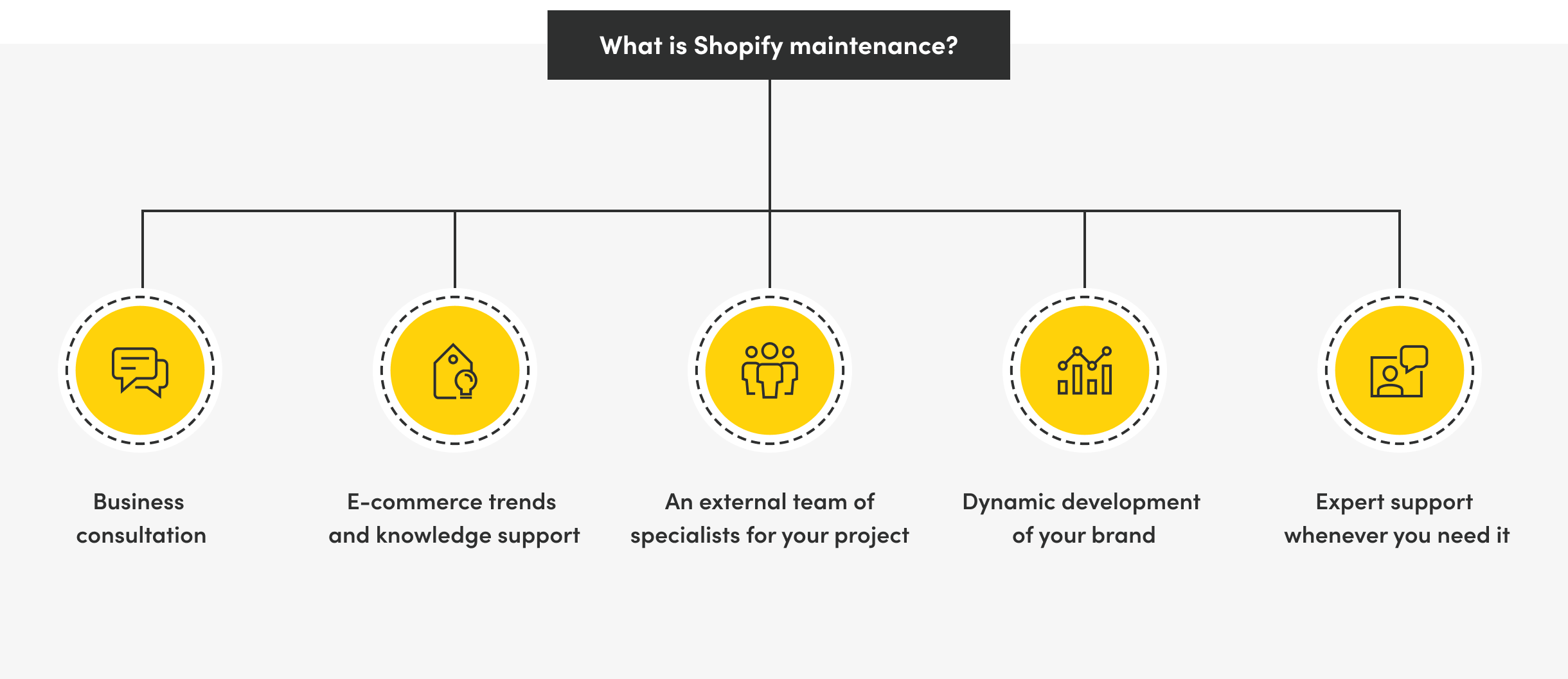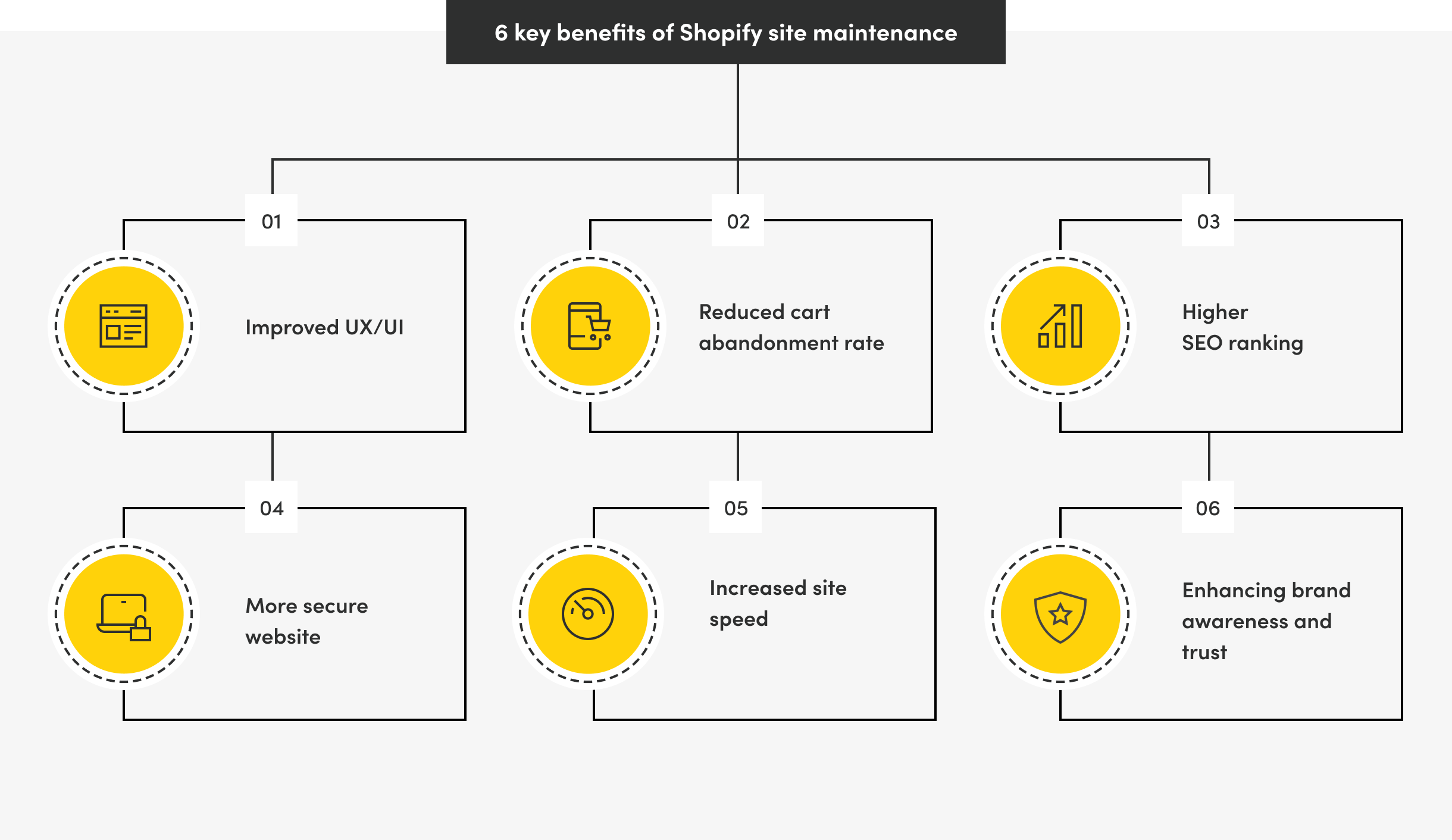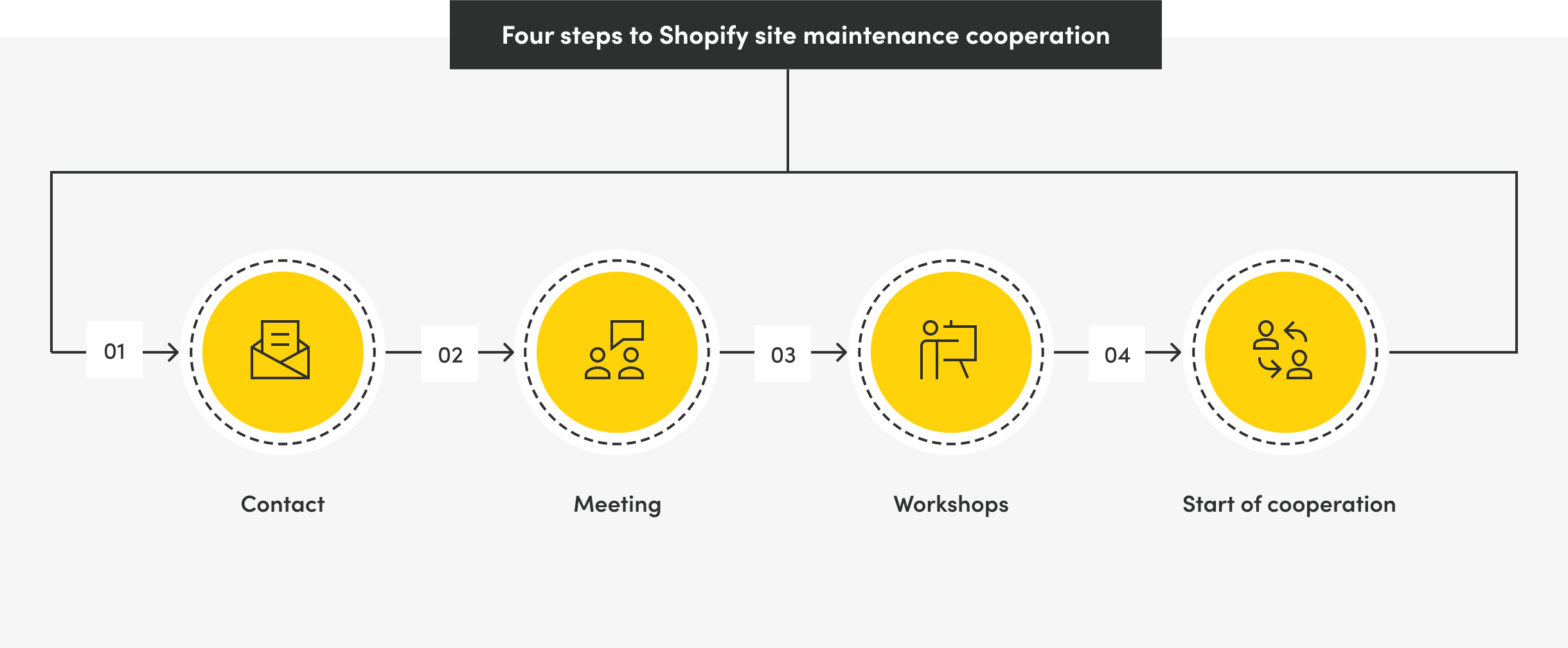But, well, at least you don’t need to worry about regular cleaning or fixing faulty appliances, right?
Well, not exactly. While you won’t have problems with malfunctioning automatic doors or flickering light bulbs like in a regular store, there are plenty of things inside your online store that require regular cleaning and fixing as well. Otherwise, those initially small issues might grow big enough to negatively impact your store’s performance and your clients’ mood.
What exactly is Shopify maintenance though and why is it even that important? We’ll answer all your questions in this article – including whether should you work on store maintenance yourself or maybe it would be better to hire a Shopify support services company to take care of optimizing your store for you.
What is Shopify website maintenance?
To ensure the success of your Shopify store, it’s crucial to maintain its performance and overall health. This involves monitoring the website, updating information, and resolving any issues that arise. By staying vigilant, you can identify and address small problems before they escalate and negatively impact your online business. For instance, if your online signup form freezes users’ browsers when they attempt to create an account, it’s likely that these potential customers won’t try again, resulting in lost clients.
If you want to encourage customers to return to your e-commerce store and make regular purchases, having a clean, fast, and secure website is just as important as having well-organized retail shelves and a functional credit card terminal. Therefore, regularly monitoring your website’s behavior and creating a maintenance plan are essential aspects of running your business.
A maintenance plan, in its simplest form, consists of a list of elements within your Shopify store that require regular optimization. It also includes a schedule outlining who should perform the maintenance and when it should be done.

The Shopify maintenance plan should especially include those tasks:
- Gathering and comparing data from the analytics tools (traffic analytics, heatmaps, Shopify in-built tools, etc.)
- Doing regular data backup
- Adding regular updates to any software and website plugins you use for the store (or remove them if they are no longer needed)
- Searching for and fixing any broken links inside your store.
- Checking how the store looks and works on different devices (desktop and mobile ones)
- Scanning and fixing technical issues
- Updating your content and store template
- Testing all pages for speed and performance
- Doing a routine security scan for any code vulnerabilities, malicious code, potential security breaches, etc.
If you are unsure where to start with drafting such a plan, it might be worth it to contact companies working as the Shopify support team, who can help you create such a plan for your brand and give you tips on how to stick to it.
💡 See also: our maintenance services for Reckitt – case study.

What are the key benefits of Shopify site maintenance?
Keeping all those tasks scheduled and completed might seem like a lot of work, but if you want to keep your site healthy, secure, and engaging for your visitors, regular Shopify maintenance is a must. Especially making sure that your store is up-to-date and fully optimized can also bring you, as the Shopify store owner, plenty of benefits – here are some of them.

Improved user experience
The biggest benefit of regular website check-ins is that it allows you to keep a smooth and enjoyable user experience for your shoppers. When your site is easy to navigate, loads fast and works well on mobile devices, then shoppers are more likely to purchase something on your site – and come back to you later.
On the other hand, if they land on a page that takes ages to load, freezes their browser, or barely works on their smartphone or tablet, then there’s a high chance they will leave and never return. With 88% of consumers stating that they are less likely to return to a site with bad UX, you just can’t afford to neglect your store performance (the same goes for apps, by the way).
By regularly checking how your website behaves and taking care of any issues that could affect the store performance, you can keep your customers happier and returning to your store more often.
Reduced bounce rate/cart abandonment rate
From Forrester research: e-commerce brands lose $18 Billion in yearly sales revenue because of abandoned shopping carts. Are those also your problem? Then having a closer look at your store and updating it might (at least in part) help you find the culprit. Yes, there are dozens of reasons why shoppers might change their minds about shopping with you and some of them might be out of your control. However, slow loading speed, confusing navigation, and long and complicated checkout are often mentioned as the biggest reasons why customers decide to look for another store – even if they did want to purchase something from you.
A good idea here is to have a look at your analytics data to see where might the problem be and when did it start – especially using heatmaps can be very useful here.
Higher SEO ranking
Search engine algorithms love and rank higher websites that are fast, meet all SEO best practices, and are regularly updated with fresh content. So if you want to boost your search engine ranking, a maintenance check will be very helpful here. Fixing all broken links, improving the speed of your website, and making sure that your mobile website works as it should will give you a better ranking.
However, you should also take care of the content on your website. Polishing the meta descriptions, updating the information inside the blog post or infographics, and adding new keywords are all nice ideas on how you can get the SEO crawlers to put your website higher.
More secure website
Over 18 million websites are infected with malware each week, yikes. Even scarier is that according to CyberSecurity Ventures, businesses suffered a ransomware attack every 11 seconds in 2021. And Cybersecurity experts believe the number will go even lower, to 2-3 seconds.
While the Shopify platform does have plenty of security features in place, you should also do your due diligence. An outdated website with several plugins that were not updated in a long time is a perfect target for criminals. If you want to minimize the risk of being attacked (and dealing with eventual damages), then regularly updating the software and plugins you are using, backing up your data, and patching all code vulnerabilities is essential.
Increase site speed
What is a one-second delay when it comes to your e-commerce store? Looking at CrazyEgg’s research, that’s, on average, 11% fewer page views, 16% decrease in customer satisfaction, and 7% loss in conversions. That means that one second can decide whether you will have a sale or not. Regularly testing and optimizing your store’s speed is therefore essential.
But it’s not only your desktop store you should optimize – most Shopify users expect your mobile page will work just as smoothly as the desktop one. If your mobile website can’t exactly meet the expectations though, then it’s a good time to look for any elements that may be slowing your site down. We gave some tips on how you can make your Shopify store work much faster than before in our previous article, Shopify store speed optimization – they should be helpful when it comes to shaving one or two seconds out of your loading time.
Build brand awareness and trust
The last benefit is that regularly maintaining and optimizing your website shows you as a professional company that wants to give its users the best shopping experience possible.
Internet users have a pretty good eye when it comes to the websites they visit and can quickly tell whether someone is regularly updating the page or not. Seeing that the last article is from January (when we have August) or that design looks more than outdated, makes the visitors doubt is your company still in business. And that will directly affect your conversion rates and revenue.
Frequent website downtime, page freezes, or frustrating issues with which no one seems to be doing anything can be just as disastrous for your brand’s reputation – 88% of online shoppers won’t return to a site after a bad user experience.
Alternatively, if you consistently improve your Shopify website to make it as useful as possible for customers, your store (and your brand) can become their “go-to” website. And even spread a good word about your brand – 23% of people who’ve had a positive UX tell ten or more people about the page. That’s surely worth a bit of effort.
What might be the consequences of not doing website maintenance?
Many businesses tend to put off website maintenance for later or do just the bare minimum because of how much time and effort it might take them to research and update their stores. And unfortunately, they only realize once they have to deal with a sudden website downtime or a database attack that they could have avoided all those problems if they just spent time on proper maintenance. Just because of slow-loading websites, businesses lose $2.6 billion a year!
But there are far more problems that might come together with neglecting the maintenance:
- Falling website traffic (and conversion rates)
- Low SEO rankings
- Frequent cyberattacks and infections (Google takes down several websites daily because of malware infections, and you surely do not want yours to be one of them!)
- Poor customer satisfaction and, as a result, low perception of your brand
Fixing a website downtime caused by a hacker attack or trying to get your website back to page 1 of Google search results would take you both far more time and budget than doing regular website maintenance would take. And what about restoring your damaged reputation and trust in your services? It could take several months – if not longer. And with so much competition in the e-commerce market, losing customers to slow mobile website or database leaks might mean the end of your business.
What if you need a bit more with Shopify site maintenance though, because you don’t have the time or skills needed? Then you should turn to Shopify maintenance and support services for help in keeping your website fresh.
Check our Shopify Maintenance and Support services
Shopify is known for how easy it is to customize its store even if you don’t have any coding skills. Still, though, the number of things you can do yourself is pretty limited. You can add new features via Shopify apps or add simple design changes, but if you want to fix the slow loading speed of your website, remake the shop template or find out why the number of conversions has dropped, you should reach out to Shopify experts. Many development companies now offer Shopify support and maintenance plans (with a scheduled number of hours) that includes guaranteed monthly support for their customers.
At WeCanFly, we can offer Shopify support services and ongoing maintenance as well.
Whether you need a quick fix for your website design, help with clearing bugs, or are looking for someone to keep your website working smoothly, WeCanFly is here to help. As a Shopify partner, we worked with multiple brands using both Shopify and Shopify Plus (like 303 Avenue or L’occitane) to help them manage and update their stores – or to offer ongoing Shopify support services.
With what we can help your brand:
- UX and UI (creating new theme designs or refreshing the current ones)
- Bug fixes
- Testing and Implementation of new functionalities
- Help in product and store configuration, integrating new e-commerce platforms into the store, or solving compatibility issues
- Testing your store for conversion or usability issues
- Shopify support and maintenance in long term
- Adding regular updates to the Shopify site (such as adding custom features or new theme installation)
- Regularly updating and maintaining the apps created by us (like the Polish delivery methods integration app )
Most importantly, our maintenance plan guarantees that there will always be someone to help you with an issue in your store and for as long as our help will be needed. So in case of any sudden issues, you can count on a quick response from us.
While our maintenance and support plans have a set number of hours each month (minimum 4), there’s no problem with extending the support time if the issue requires it. We’ll schedule extra time for you (depending on our workload) and agree on an hourly rate for our service. Time spent on the issue will be tracked in Toggl’s time tracking app, plus you’ll get a report at the end of our work, so you will know exactly what you are paying.
In the beginning, it is recommended that you sign up for a 3-month pilot program, then upgrade to a 6- or 12-month contract.

Let’s create the best solution tailored for your store with WeCanFly
If you want your Shopify store to bring as many customers to your store as possible, then scheduling time for regular website maintenance is absolutely essential. Spending a bit of time on spotting and patching security issues, speeding your store, and refreshing your content can save you time, money, and unnecessary trouble in the long run. And most importantly, it will make your shoppers much more likely to stop by your store and buy something from you.
So put those website maintenance steps on your calendar and stick to them – or ask WeCanFly to do it for you if you’d rather leave the maintenance to Shopify experts 🙂


